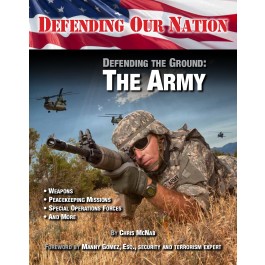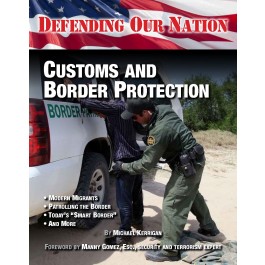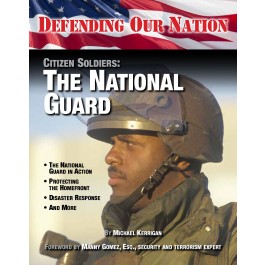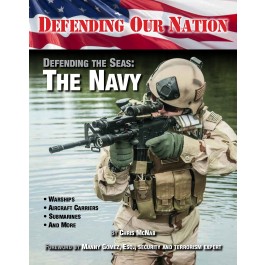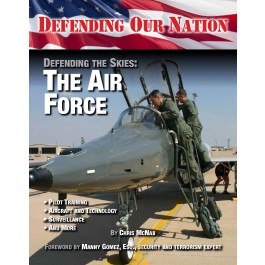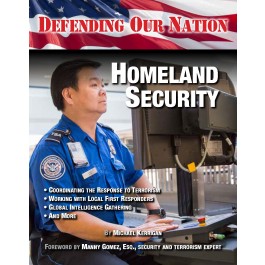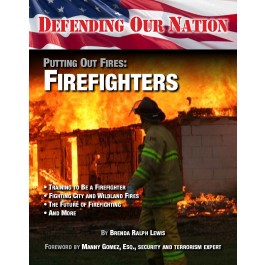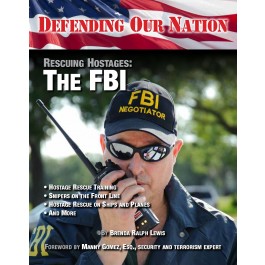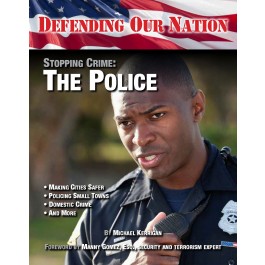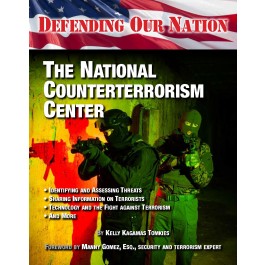DEFENDING OUR NATION

12
2018
12+
7th - 12th
7 X 9
Booklist Review
"These books will be useful to younger teens undertaking initial career research. In each title, necessary education is discussed in broad terms as it relates to the topic of the specific book, and employment projections are included to encourage early teens to begin planning for their futures."LMC Review
"These books will be useful to younger teens undertaking initial career research. In each title, necessary education is discussed in broad terms as it relates to the topic of the specific book, and employment projections are included to encourage early teens to begin planning for their futures."SLJ Review
"These books will be useful to younger teens undertaking initial career research. In each title, necessary education is discussed in broad terms as it relates to the topic of the specific book, and employment projections are included to encourage early teens to begin planning for their futures."Voya Review
"These books will be useful to younger teens undertaking initial career research. In each title, necessary education is discussed in broad terms as it relates to the topic of the specific book, and employment projections are included to encourage early teens to begin planning for their futures."CLCD Review
"These books will be useful to younger teens undertaking initial career research. In each title, necessary education is discussed in broad terms as it relates to the topic of the specific book, and employment projections are included to encourage early teens to begin planning for their futures."by Chris McNab
| Hardcover | ISBN 978-1-4222-3762-5 | $24.95 | Add To Cart |
| eBook | ISBN 978-1-4222-8018-8 | $31.95 | Add To Cart |
The U.S. Army is the most powerful military force on Earth. Every hour of every day it guards the United States and its citizens at home and abroad, ready to respond to any emergency with its elite personnel, hi-tech equipment, and massive firepower. This book explores how the U.S. Army defends freedom and democracy around the world. Since its creation, the Army has proved itself fighting wars as well as keeping the peace by deterring aggression. Today, Army soldiers are engaged deeply in the battle against terrorism, risking their lives to ensure that America does not suffer further terrorist attacks. Defending the Ground takes a comprehensive look at the history, roles, and capabilities of our ground troops from 1775 to the present day massive military force. Discover the advanced weapons systems that allow the Army to dominate the battlefield. Learn about the Army's structure and what it takes to become a soldier. PUBLISHER'S NOTE: Each title in this series contains a foreword from
a noted security and antiterrorism expert who has served in the FBI, Marines, and police force, color photos throughout, and back matter that includes an index, chronology, and further resource lists of books and Internet resources. Key Icons appear throughout the books in this series, encouraging library readers to build knowledge, gain awareness, explore possibilities and expand their viewpoints through our content-rich nonfiction books. Key Icons in this series are as follows: Words to Understand are shown at the front of each chapter with definitions. These words are set in boldfaced type in that chapter, so that readers can reference back to the definitions--building their vocabulary and enhancing their reading comprehension. Sidebars are highlighted graphics with content rich material within that allows readers to build knowledge and broaden their perspectives by weaving together additional information to provide realistic and holistic perspectives. Text-Dependent Questions are placed at the end of each chapter. They challenge the reader's comprehension of the chapter they have just read, while sending the reader back to the text for more careful attention to the evidence presented there. Research Projects are provided at the end of each chapter as well and provide readers with suggestions for projects that encourage deeper research and analysis. Educational Videos provide links via QR codes to online video content that gives a multimedia dimension to the topics. And a Series Glossary of Key Terms is included in the back matter containing terminology used throughout the series. Words found here broaden the reader's knowledge and understanding of terms used in this field.
by Michael Kerrigan
| Hardcover | ISBN 978-1-4222-3761-8 | $24.95 | Add To Cart |
| eBook | ISBN 978-1-4222-8017-1 | $31.95 | Add To Cart |
America has always been a nation of immigrants. In addition to the approximately 1 million immigrants who enter the United States legally each year, millions more enter without documentation or overstay their visas. It is the job of Customs and Border Protection (CBP) to help hard working immigrants in search of a better life to enter the U.S. legally while keeping out terrorists and other foreign nationals who would seek to harm the nation. CBP, which operates under the umbrella of the Department of Homeland Security, is one of the world's largest law enforcement organizations with more than 60,000 employees. CBP is charged with keeping terrorists and their weapons out of the U.S. while helping lawful international travel and trade. The men and women of CBP are responsible for enforcing hundreds of U.S. laws and regulations. On a typical day, CBP welcomes nearly 1 million visitors, screens more than 67,000 cargo containers, arrests more than 1,100 individuals, and seizes nearly 6 tons
of illicit drugs. This book provides an in-depth look at Customs and Border Protection and the important role it plays in keeping America a safe and strong nation of immigrants. PUBLISHER'S NOTE: Each title in this series contains a foreword from a noted security and antiterrorism expert who has served in the FBI, Marines, and police force, color photos throughout, and back matter that includes an index, chronology, and further resource lists of books and Internet resources. Key Icons appear throughout the books in this series, encouraging library readers to build knowledge, gain awareness, explore possibilities and expand their viewpoints through our content-rich nonfiction books. Key Icons in this series are as follows: Words to Understand are shown at the front of each chapter with definitions. These words are set in boldfaced type in that chapter, so that readers can reference back to the definitions--building their vocabulary and enhancing their reading comprehension. Sidebars are highlighted graphics with content rich material within that allows readers to build knowledge and broaden their perspectives by weaving together additional information to provide realistic and holistic perspectives. Text-Dependent Questions are placed at the end of each chapter. They challenge the reader's comprehension of the chapter they have just read, while sending the reader back to the text for more careful attention to the evidence presented there. Research Projects are provided at the end of each chapter as well and provide readers with suggestions for projects that encourage deeper research and analysis. Educational Videos provide links via QR codes to online video content that gives a multimedia dimension to the topics. And a Series Glossary of Key Terms is included in the back matter containing terminology used throughout the series. Words found here broaden the reader's knowledge and understanding of terms used in this field.
by Michael Kerrigan
| Hardcover | ISBN 978-1-4222-3760-1 | $24.95 | Add To Cart |
| eBook | ISBN 978-1-4222-8016-4 | $31.95 | Add To Cart |
This book honors the ordinary Americans who have sworn to defend their country as members of the National Guard. The role of the "citizen-soldier" is enshrined in U.S. tradition, dating back to the militias first formed by settlers in the 17th century. That same spirit of community self-defense would inspire the Minutemen, who, more than 100 years later, would rise up against the British to help establish the world's greatest democracy. Since then, whenever America has been under threat, the National Guard has provided the country's first line of defense--not only against enemies but also in times of natural disasters. Citizen Soldiers offers an exciting introduction to the National Guard's structure and its unique constitutional status as a federal and state institution. Along the way, we explore its missions past and present and look into the special contributions to homeland defense made by the National Guard. PUBLISHER'S NOTE: Each title in this series contains a foreword from a
noted security and antiterrorism expert who has served in the FBI, Marines, and police force, color photos throughout, and back matter that includes an index, chronology, and further resource lists of books and Internet resources. Key Icons appear throughout the books in this series, encouraging library readers to build knowledge, gain awareness, explore possibilities and expand their viewpoints through our content-rich nonfiction books. Key Icons in this series are as follows: Words to Understand are shown at the front of each chapter with definitions. These words are set in boldfaced type in that chapter, so that readers can reference back to the definitions--building their vocabulary and enhancing their reading comprehension. Sidebars are highlighted graphics with content rich material within that allows readers to build knowledge and broaden their perspectives by weaving together additional information to provide realistic and holistic perspectives. Text-Dependent Questions are placed at the end of each chapter. They challenge the reader's comprehension of the chapter they have just read, while sending the reader back to the text for more careful attention to the evidence presented there. Research Projects are provided at the end of each chapter as well and provide readers with suggestions for projects that encourage deeper research and analysis. Educational Videos provide links via QR codes to online video content that gives a multimedia dimension to the topics. And a Series Glossary of Key Terms is included in the back matter containing terminology used throughout the series. Words found here broaden the reader's knowledge and understanding of terms used in this field.
by Chris McNab
| Hardcover | ISBN 978-1-4222-3763-2 | $24.95 | Add To Cart |
| eBook | ISBN 978-1-4222-8019-5 | $31.95 | Add To Cart |
This book pays tribute to the world’s premier naval power, and its unwavering mission to protect the citizens and interests of the United States. The U.S. Navy is unique among the armed forces in that it conducts missions in the air, on land, and at sea. Established in 1775, it has kept the peace and ensured the country’s safety throughout every conflict and war. In the late 20th and early 21st century, the U.S. Navy has been used in a variety of roles from open combat to search-and-rescue missions. In addition, the Navy is involved here at home with its “stop and search” operations in the war against drugs. Defending the Seas reveals the Navy’s origin, roles, and operations. Explore some of the Navy’s largest warships, destroyers, aircraft carriers, submarines, and the new technology used to operate them. Learn about the hundreds of different jobs in the Navy and what it takes to join the Navy. PUBLISHER’S NOTE: Each title in this series contains a foreword from a noted
security and antiterrorism expert who has served in the FBI, Marines, and police force, color photos throughout, and back matter that includes an index, chronology, and further resource lists of books and Internet resources. Key Icons appear throughout the books in this series, encouraging library readers to build knowledge, gain awareness, explore possibilities and expand their viewpoints through our content-rich nonfiction books. Key Icons in this series are as follows: Words to Understand are shown at the front of each chapter with definitions. These words are set in boldfaced type in that chapter, so that readers can reference back to the definitions—building their vocabulary and enhancing their reading comprehension. Sidebars are highlighted graphics with content rich material within that allows readers to build knowledge and broaden their perspectives by weaving together additional information to provide realistic and holistic perspectives. Text-Dependent Questions are placed at the end of each chapter. They challenge the reader’s comprehension of the chapter they have just read, while sending the reader back to the text for more careful attention to the evidence presented there. Research Projects are provided at the end of each chapter as well and provide readers with suggestions for projects that encourage deeper research and analysis. Educational Videos provide links via QR codes to online video content that gives a multimedia dimension to the topics. And a Series Glossary of Key Terms is included in the back matter containing terminology used throughout the series. Words found here broaden the reader’s knowledge and understanding of terms used in this field.
by Chris McNab
| Hardcover | ISBN 978-1-4222-3764-9 | $24.95 | Add To Cart |
| eBook | ISBN 978-1-4222-8020-1 | $31.95 | Add To Cart |
This book introduces readers to the best-equipped, most elite air force in the world and its unflagging mission to protect the citizens and interests of the United States.The U.S. Air Force (USAF) was only established in 1947—44 years after the Wright Brothers first flight; yet its aircraft, equipment, and power are unrivalled. Air National Guard squadrons monitor the skies over the United States. The USAF Space Command puts surveillance satellites into orbit around the Earth. And USAF Pacific Air Forces patrol 44 countries and over 100 million square miles of territory. Such roles demand elite personnel, and the USAF training programs for pilots and ground crew alike are among the most advanced in the world. Defending the Skies explores the USAF’s origin, roles, and operations. See some of the USAF’s most technologically advanced aircraft, and surveillance technology. Learn how USAF pilots train for combat and defense what it takes to join the Air Force. PUBLISHER’S NOTE: Each
title in this series contains a foreword from a noted security and antiterrorism expert who has served in the FBI, Marines, and police force, color photos throughout, and back matter that includes an index, chronology, and further resource lists of books and Internet resources. Key Icons appear throughout the books in this series, encouraging library readers to build knowledge, gain awareness, explore possibilities and expand their viewpoints through our content-rich nonfiction books. Key Icons in this series are as follows: Words to Understand are shown at the front of each chapter with definitions. These words are set in boldfaced type in that chapter, so that readers can reference back to the definitions—building their vocabulary and enhancing their reading comprehension. Sidebars are highlighted graphics with content rich material within that allows readers to build knowledge and broaden their perspectives by weaving together additional information to provide realistic and holistic perspectives. Text-Dependent Questions are placed at the end of each chapter. They challenge the reader’s comprehension of the chapter they have just read, while sending the reader back to the text for more careful attention to the evidence presented there. Research Projects are provided at the end of each chapter as well and provide readers with suggestions for projects that encourage deeper research and analysis. Educational Videos provide links via QR codes to online video content that gives a multimedia dimension to the topics. And a Series Glossary of Key Terms is included in the back matter containing terminology used throughout the series. Words found here broaden the reader’s knowledge and understanding of terms used in this field.
by Michael Kerrigan
| Hardcover | ISBN 978-1-4222-3767-0 | $24.95 | Add To Cart |
| eBook | ISBN 978-1-4222-8023-2 | $31.95 | Add To Cart |
The terrorist attacks of September 11, 2001—the worst ever on U.S. soil—highlighted a dangerous vulnerability in America’s protection strategies. The big question everyone was asking was how could a country with the world’s most formidable armed forces have found itself so defenseless against determined—but relatively poorly equipped—enemies? Formed in direct response to the 2001 attacks, the Department of Homeland Security was intended to make sure such an attack would not occur again. With a unified strategy of military and civil defense, Homeland Security has already done much to fulfill its mission: keeping the nation safe from the many threats we face. Homeland Security’s more than 240,000 employees focus on everything from aviation and border security to emergency response, and cybersecurity. Homeland Security discusses the establishment of the department after September 11, 2001 and the changes that have been made since then to equip first responders for the
challenges ahead. PUBLISHER’S NOTE: Each title in this series contains a foreword from a noted security and antiterrorism expert who has served in the FBI, Marines, and police force, color photos throughout, and back matter that includes an index, chronology, and further resource lists of books and Internet resources. Key Icons appear throughout the books in this series, encouraging library readers to build knowledge, gain awareness, explore possibilities and expand their viewpoints through our content-rich nonfiction books. Key Icons in this series are as follows: Words to Understand are shown at the front of each chapter with definitions. These words are set in boldfaced type in that chapter, so that readers can reference back to the definitions—building their vocabulary and enhancing their reading comprehension. Sidebars are highlighted graphics with content rich material within that allows readers to build knowledge and broaden their perspectives by weaving together additional information to provide realistic and holistic perspectives. Text-Dependent Questions are placed at the end of each chapter. They challenge the reader’s comprehension of the chapter they have just read, while sending the reader back to the text for more careful attention to the evidence presented there. Research Projects are provided at the end of each chapter as well and provide readers with suggestions for projects that encourage deeper research and analysis. Educational Videos provide links via QR codes to online video content that gives a multimedia dimension to the topics. And a Series Glossary of Key Terms is included in the back matter containing terminology used throughout the series. Words found here broaden the reader’s knowledge and understanding of terms used in this field.
by Michael Kerrigan
| Hardcover | ISBN 978-1-4222-3768-7 | $24.95 | Add To Cart |
| eBook | ISBN 978-1-4222-8024-9 | $31.95 | Add To Cart |
Of all the threats to peace and democracy in the world today, few are more disturbing than that of biological or chemical warfare. These weapons are cheap to make and easy to use, which has made them the ideal choice for a new and sinister breed of terrorists. Protecting against Biological and Chemical Attack is a fascinating introduction to the main types of biological and chemical weapons, including their history, applications, and limitations. The reader will find grounds for confidence as well as for concern. The United States is by no means defenseless in the face of this evil. This book explains the actions currently being taken by the authorities to defend against biological and chemical warfare and how ordinary Americans can help protect themselves and their country. PUBLISHER’S NOTE: Each title in this series contains a foreword from a noted security and antiterrorism expert who has served in the FBI, Marines, and police force, color photos throughout, and back matter that
includes an index, chronology, and further resource lists of books and Internet resources. Key Icons appear throughout the books in this series, encouraging library readers to build knowledge, gain awareness, explore possibilities and expand their viewpoints through our content-rich nonfiction books. Key Icons in this series are as follows: Words to Understand are shown at the front of each chapter with definitions. These words are set in boldfaced type in that chapter, so that readers can reference back to the definitions—building their vocabulary and enhancing their reading comprehension. Sidebars are highlighted graphics with content rich material within that allows readers to build knowledge and broaden their perspectives by weaving together additional information to provide realistic and holistic perspectives. Text-Dependent Questions are placed at the end of each chapter. They challenge the reader’s comprehension of the chapter they have just read, while sending the reader back to the text for more careful attention to the evidence presented there. Research Projects are provided at the end of each chapter as well and provide readers with suggestions for projects that encourage deeper research and analysis. Educational Videos provide links via QR codes to online video content that gives a multimedia dimension to the topics. And a Series Glossary of Key Terms is included in the back matter containing terminology used throughout the series. Words found here broaden the reader’s knowledge and understanding of terms used in this field.
by Brenda Ralph Lewis
| Hardcover | ISBN 978-1-4222-3769-4 | $24.95 | Add To Cart |
| eBook | ISBN 978-1-4222-8025-6 | $31.95 | Add To Cart |
Fire is simultaneously humanity’s best friend and our most ruthless enemy. Fire warms and comforts, enables us to cook food, and powers much of our industry. But it can also be a raging killer. Once out of control, it destroys homes, lives, and lays waste to vast areas of land. Firefighters have a long history of courage and sacrifice in overcoming flames to safeguard their communities. The New York City firefighters, who risked and lost their lives fighting the fires at the World Trade Center on September 11, 2001, were some of the more recent additions to a long line of firefighting heroes. Putting Out Fires examines the lives of firefighters, the training they undergo, and the hardships they endure while fighting fires. Learn about the special dangers of wildfires and aircraft fires and what the future of firefighting looks like. This book offers a comprehensive look at the history of firefighting and what it takes to be a firefighter. PUBLISHER’S NOTE: Each title in this series
contains a foreword from a noted security and antiterrorism expert who has served in the FBI, Marines, and police force, color photos throughout, and back matter that includes an index, chronology, and further resource lists of books and Internet resources. Key Icons appear throughout the books in this series, encouraging library readers to build knowledge, gain awareness, explore possibilities and expand their viewpoints through our content-rich nonfiction books. Key Icons in this series are as follows: Words to Understand are shown at the front of each chapter with definitions. These words are set in boldfaced type in that chapter, so that readers can reference back to the definitions—building their vocabulary and enhancing their reading comprehension. Sidebars are highlighted graphics with content rich material within that allows readers to build knowledge and broaden their perspectives by weaving together additional information to provide realistic and holistic perspectives. Text-Dependent Questions are placed at the end of each chapter. They challenge the reader’s comprehension of the chapter they have just read, while sending the reader back to the text for more careful attention to the evidence presented there. Research Projects are provided at the end of each chapter as well and provide readers with suggestions for projects that encourage deeper research and analysis. Educational Videos provide links via QR codes to online video content that gives a multimedia dimension to the topics. And a Series Glossary of Key Terms is included in the back matter containing terminology used throughout the series. Words found here broaden the reader’s knowledge and understanding of terms used in this field.
by Brenda Ralph Lewis
| Hardcover | ISBN 978-1-4222-3770-0 | $24.95 | Add To Cart |
| eBook | ISBN 978-1-4222-8026-3 | $31.95 | Add To Cart |
Rescuing hostages from captors, who are frequently violent, is one of the hardest jobs in the world. Kidnapping is nothing new. It’s been a fact of life since before recorded history, but kidnapping has a different face today as both domestic and foreign terrorists with political aims use it as a means of blackmailing governments and publicizing their causes worldwide. This book tells the story of the extraordinary men and women who with courage, patience, ingenuity, and psychological insight handle high-stakes hostage-rescue situations. Hostage rescuers regularly risk their lives to save the lives of victims. Rescuing Hostages explores this difficult, stressful world in which innocent people are ruthlessly used as bargaining tools. These highly trained agents are often a hostage’s best and only hope. PUBLISHER’S NOTE: Each title in this series contains a foreword from a noted security and antiterrorism expert who has served in the FBI, Marines, and police force, color photos
throughout, and back matter that includes an index, chronology, and further resource lists of books and Internet resources. Key Icons appear throughout the books in this series, encouraging library readers to build knowledge, gain awareness, explore possibilities and expand their viewpoints through our content-rich nonfiction books. Key Icons in this series are as follows: Words to Understand are shown at the front of each chapter with definitions. These words are set in boldfaced type in that chapter, so that readers can reference back to the definitions—building their vocabulary and enhancing their reading comprehension. Sidebars are highlighted graphics with content rich material within that allows readers to build knowledge and broaden their perspectives by weaving together additional information to provide realistic and holistic perspectives. Text-Dependent Questions are placed at the end of each chapter. They challenge the reader’s comprehension of the chapter they have just read, while sending the reader back to the text for more careful attention to the evidence presented there. Research Projects are provided at the end of each chapter as well and provide readers with suggestions for projects that encourage deeper research and analysis. Educational Videos provide links via QR codes to online video content that gives a multimedia dimension to the topics. And a Series Glossary of Key Terms is included in the back matter containing terminology used throughout the series. Words found here broaden the reader’s knowledge and understanding of terms used in this field.
by Michael Kerrigan
| Hardcover | ISBN 978-1-4222-3771-7 | $24.95 | Add To Cart |
| eBook | ISBN 978-1-4222-8027-0 | $31.95 | Add To Cart |
Crime drains our society of billions of dollars every year and takes an appalling toll in terms of death and fear. Eliminating crime entirely is not possible, but prevention is. Police officers bravely patrol our cities and towns to keep us safe. But they cannot do it alone. There are many things we can do to help protect ourselves against crime. Under the expert guidance of police forces, ordinary citizens throughout the United States have come together to defend themselves and their neighbors against criminals. The success of such programs has already been extraordinary, but much more remains to be done. As this book shows, combating crime with a police-community partnership is by far the best defense. With special emphasis on actual projects in crime-stricken communities around the world, Stopping Crime reveals how police and public can work together for the good of everyone. PUBLISHER’S NOTE: Each title in this series contains a foreword from a noted security and antiterrorism
expert who has served in the FBI, Marines, and police force, color photos throughout, and back matter that includes an index, chronology, and further resource lists of books and Internet resources. Key Icons appear throughout the books in this series, encouraging library readers to build knowledge, gain awareness, explore possibilities and expand their viewpoints through our content-rich nonfiction books. Key Icons in this series are as follows: Words to Understand are shown at the front of each chapter with definitions. These words are set in boldfaced type in that chapter, so that readers can reference back to the definitions—building their vocabulary and enhancing their reading comprehension. Sidebars are highlighted graphics with content rich material within that allows readers to build knowledge and broaden their perspectives by weaving together additional information to provide realistic and holistic perspectives. Text-Dependent Questions are placed at the end of each chapter. They challenge the reader’s comprehension of the chapter they have just read, while sending the reader back to the text for more careful attention to the evidence presented there. Research Projects are provided at the end of each chapter as well and provide readers with suggestions for projects that encourage deeper research and analysis. Educational Videos provide links via QR codes to online video content that gives a multimedia dimension to the topics. And a Series Glossary of Key Terms is included in the back matter containing terminology used throughout the series. Words found here broaden the reader’s knowledge and understanding of terms used in this field.
by Clive Somerville
| Hardcover | ISBN 978-1-4222-3765-6 | $24.95 | Add To Cart |
| eBook | ISBN 978-1-4222-8021-8 | $31.95 | Add To Cart |
The men and women of the Drug Enforcement Administration (DEA) are dedicated to protecting our nation from the scourge of drugs and the violence that too often accompanies it. DEA agents work tirelessly to enforce U.S. drug laws, bringing those who break them to justice. They clean up our communities ravaged by drug gangs. The DEA is also heavily involved in fighting the drug trade around the world to prevent it from reaching American shores. Fighting the illegal drug trade is a difficult and dangerous assignment, but the men and women of the DEA face this danger every day to make the United States a safer place. The Drug Enforcement Administration offers a behind-the-scenes look at the DEA’s history, mission, and operations in our communities and abroad. PUBLISHER’S NOTE: Each title in this series contains a foreword from a noted security and antiterrorism expert who has served in the FBI, Marines, and police force, color photos throughout, and back matter that includes an index,
chronology, and further resource lists of books and Internet resources. Key Icons appear throughout the books in this series, encouraging library readers to build knowledge, gain awareness, explore possibilities and expand their viewpoints through our content-rich nonfiction books. Key Icons in this series are as follows: Words to Understand are shown at the front of each chapter with definitions. These words are set in boldfaced type in that chapter, so that readers can reference back to the definitions—building their vocabulary and enhancing their reading comprehension. Sidebars are highlighted graphics with content rich material within that allows readers to build knowledge and broaden their perspectives by weaving together additional information to provide realistic and holistic perspectives. Text-Dependent Questions are placed at the end of each chapter. They challenge the reader’s comprehension of the chapter they have just read, while sending the reader back to the text for more careful attention to the evidence presented there. Research Projects are provided at the end of each chapter as well and provide readers with suggestions for projects that encourage deeper research and analysis. Educational Videos provide links via QR codes to online video content that gives a multimedia dimension to the topics. And a Series Glossary of Key Terms is included in the back matter containing terminology used throughout the series. Words found here broaden the reader’s knowledge and understanding of terms used in this field.
by Kelly Kagamas Tomkies
| Hardcover | ISBN 978-1-4222-3766-3 | $24.95 | Add To Cart |
| eBook | ISBN 978-1-4222-8022-5 | $31.95 | Add To Cart |
Following the al Qaeda terrorist attacks of September 11, 2001, the U.S. government convened a special commission to investigate the intelligence failure that allowed the attacks to happen. Known informally as the 9/11 Commission, its report concluded among other things that “none of the measures adopted by the U.S. government before 9/11 disturbed or even delayed the progress of the al Qaeda plot.” An important step toward addressing this failure was the formation of the National Counterterrorism Center (NCTC). Successfully combatting terrorism often comes down to the quality of the intelligence that’s gathered. That’s where the NCTC comes in. Established in 2002, this agency gathers intelligence 24/7, staying on the continuous lookout for potential threats. It has access to intelligence gathered by the CIA and National Security Agency as well as maintaining its own databases. Learn about this crucial new bureau and how it synchronizes operations across more than 20 government
departments and agencies within the United States and many more around the world to keep people safe from terrorist attacks. PUBLISHER’S NOTE: Each title in this series contains a foreword from a noted security and antiterrorism expert who has served in the FBI, Marines, and police force, color photos throughout, and back matter that includes an index, chronology, and further resource lists of books and Internet resources. Key Icons appear throughout the books in this series, encouraging library readers to build knowledge, gain awareness, explore possibilities and expand their viewpoints through our content-rich nonfiction books. Key Icons in this series are as follows: Words to Understand are shown at the front of each chapter with definitions. These words are set in boldfaced type in that chapter, so that readers can reference back to the definitions—building their vocabulary and enhancing their reading comprehension. Sidebars are highlighted graphics with content rich material within that allows readers to build knowledge and broaden their perspectives by weaving together additional information to provide realistic and holistic perspectives. Text-Dependent Questions are placed at the end of each chapter. They challenge the reader’s comprehension of the chapter they have just read, while sending the reader back to the text for more careful attention to the evidence presented there. Research Projects are provided at the end of each chapter as well and provide readers with suggestions for projects that encourage deeper research and analysis. Educational Videos provide links via QR codes to online video content that gives a multimedia dimension to the topics. And a Series Glossary of Key Terms is included in the back matter containing terminology used throughout the series. Words found here broaden the reader’s knowledge and understanding of terms used in this field.











